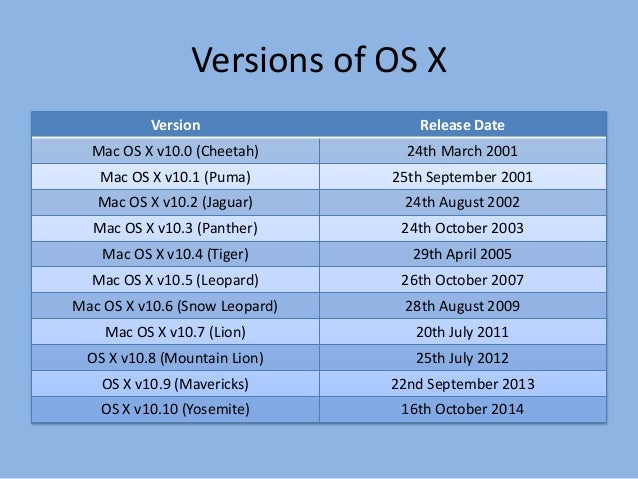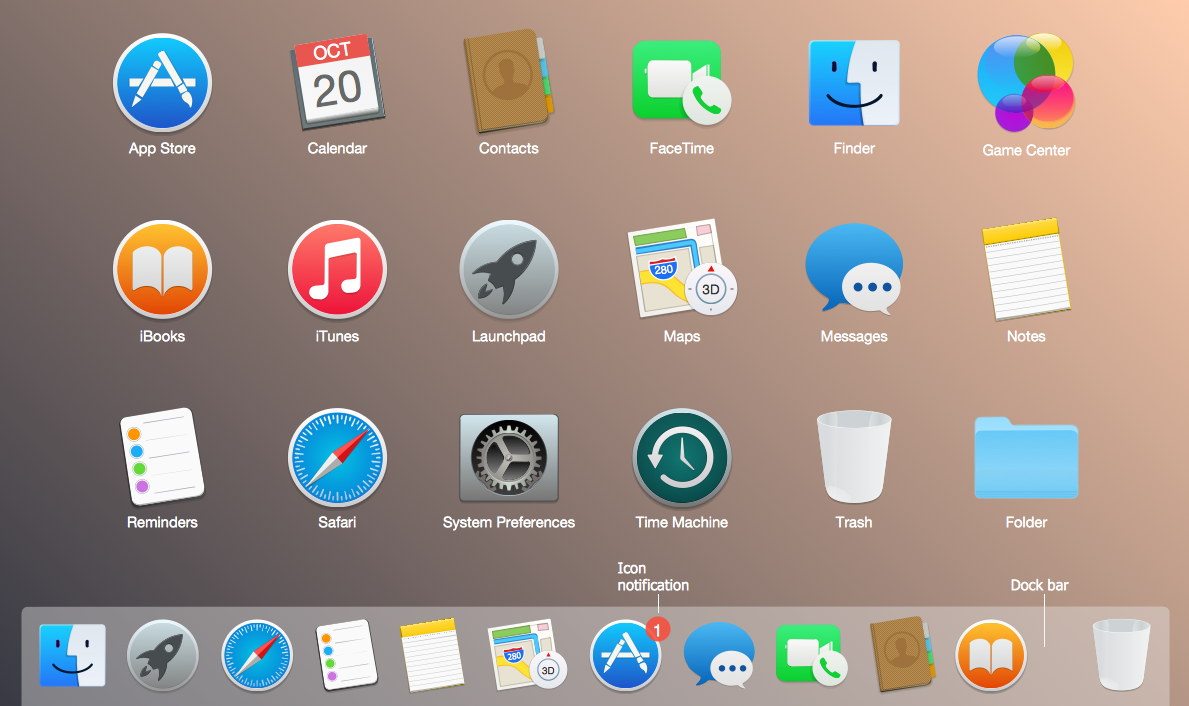| Year | Event |
|---|---|
| 1978 | In June 1978, Apple introduced Apple DOS 3.1, the first operating system for the Apple computers. |
| 1984 | Apple introduced System 1 in 1984. |
| 1985 | Apple introduced System 2 in 1985. |
| 1986 | Apple introduced System 3 in 1986. |
| 1987 | Apple introduced System 4 in 1987. |
| 1988 | Apple introduced System 6 in 1988. |
| 1991 | Apple introduced System 7 operating system on May 13, 1991. |
| 1995 | Apple allowed other computer companies to clone its computer by announcing it licensed the Macintosh operating system rights to Radius on January 4. |
| 1997 | Apple introduced macOS 8 in 1997. |
| 1997 | Apple bought NeXT Software Inc. for $400 million and acquired Steve Jobs, Apple co-founder, as a consultant. |
| 1999 | Apple introduced macOS 9 in 1999. |
| 1999 | Apple released macOS X Server 1.0 on March 16, 1999. |
| 2001 | Apple introduced macOS X 10.0, code-named Cheetah, and became available on March 24, 2001. |
| 2001 | Apple introduced macOS X 10.1, code-named Puma, and became available on September 25, 2001. |
| 2002 | Apple introduced macOS X 10.2, code-named Jaguar, and became available on August 23, 2002. |
| 2003 | Apple introduced macOS X 10.3, code-named Panther, on October 25, 2003. |
| 2004 | Apple introduced macOS X 10.4, code-named Tiger, at the WWDC on June 28, 2004. |
| 2007 | Apple introduced macOS X 10.5, code-named Leopard, on October 26, 2007. |
| 2008 | Apple introduced MobileMe at the WWDC on June 9, 2008. |
| 2009 | Apple introduced macOS X 10.6, code-named Snow Leopard, at the WWDC on June 8, 2009. |
| 2010 | Apple introduced macOS X 10.7, code-named Lion, at the 'Back to the Mac' event on October 20, 2010. The operating system was later released on July 20, 2011. New features included AirDrop, Gatekeeper, and many more. |
| 2012 | Apple released macOS X 10.8, code-named Mountain Lion, on July 25, 2012. |
| 2013 | Apple introduced macOS X 10.9, code-named Mavericks, at the WWDC on June 10, 2013. |
| 2014 | Apple introduced macOS X 10.10, code-named Yosemite, at the WWDC on June 2, 2014. Yosemite was later released on October 16, 2014. |
| 2014 | Apple introduced Force Touch, a haptic feedback system for macOS. Simultaneously, they launch a similar feedback system for iOS called 3D Touch. |
| 2015 | Apple introduced macOS X 10.11, code-named El Capitan, at the WWDC on June 8, 2015. |
| 2016 | Apple introduced macOS X 10.12, code-named Sierra, at the WWDC on June 13, 2016. |
| 2017 | Apple introduced macOS X 10.13, code-named High Sierra, at the WWDC on June 5, 2017. |
| 2018 | Apple introduced macOS X 10.14, code-named Mojave, at the WWDC on June 4, 2018. |
| 2018 | Apple introduced Dark Mode in macOS X 10.14 (Mojave), a feature that turns the background to black and text to white. Dark Mode is easier on users' eyes at night, reducing eye strain. |
| 2019 | Apple introduced macOS X 10.15, code-named Catalina, at the WWDC on June 3, 2019. |
Simpler way of managing projects
The history of macOS, Apple's current Mac operating system originally named Mac OS X until 2012 and then OS X until 2016, began with the company's project to replace its 'classic' Mac OS. That system, up to and including its final release Mac OS 9, was a direct descendant of the operating system Apple had used in its Macintosh computers since. We've compiled a list of the questions we get asked most frequently along with answers and links to columns: read our super FAQ to see if your question is covered. IOS was previously known as iPhone OS, despite also being available on the iPod Touch (1st, 2nd, and 3rd generations) and the original iPad. IPhone OS 1 – derived from 'OS X' (At the time, 'macOS' was still known as 'Mac OS X' and not 'OS X' as it was known from 2012 to 2016.). 03 / 2001 – OS X 10.0. The history of macOS started with a bear, not a cat: in September of 2000, Apple presented Kodiak. For 30$, users could purchase this first public Beta of Mac OS X. The official OS 10.0, Cheetah, followed 6 months later. Release history for Office for Mac. The following table provides release history information and download links for Office for Mac. The table is ordered by release date, with the most recent release date listed first. The build date is listed in parentheses, in a YYMMDD format, after the version number. All releases after August 22, 2016 are 64.
Stop overspending over complex project management tools. With Any.do's all-in-one Mac app, you and your team are able to track tasks and events, post files and collaborate intuitively. Built to enable maximal customization, your Any.do will feel completely your own.
'I have tried many, many list managers and I finally stuck with on Any.do. I especially like the intuitive way it helps me organize my tasks into a Today list, a Tomorrow list, an Upcoming list and a Someday list. Formatting a wd drive for mac. Optional reminders for the really important things are great too, as well as the ability to add notes and subtasks to any item. The mobile-desktop synchronization makes it a complete package; I am constantly adding, changing and completing tasks from my phone as well as from my Mac. I also appreciate the fact that there is a free version of this app that doesn't have ads in it. I highly recommend Any.do to anyone who wants a simple, clean, intuitive to-do list manager.'
KM[email protected]| Any.do for ios'I've used a few to do lists. This is the easiest to use and the sync across the Mac and iPhone is excellent.'
ATatthelawrences | Any.do for ios'This little app is great. Not only is there an app for the Mac it means I can have my up to date list whether checking phone or laptop.'
MAMagicsleeper | Any.do for ios'I've used a few to do lists. This is the easiest to use and the sync across the Mac and iPhone is excellent.'
ATatthelawrences | Any.do for ios'So far, so awesome! Just got Any.DO set up on my mac, iPhone, and Alexa. It seems to be working great. I'll update you again after a few weeks of use. But it looks like a winner!'
DODolfZone | Any.do for ios'Love this app. Adobe premiere pro mac mini. I use it to keep track of things I need to do during my day to day task and at university. I also use the sister app on my mac which syncs directly with the iOS app. Definitely recommend it!'

Designed for Mac, works everywhere

Designed for Mac, works everywhere
When outside of your home or office, check on your tasks and events on mobile, tablets, smart watches and even virtual assistants. Aimed at pushing your productivity to the max, all devices are in real-time sync so you can meet your goals.
Available on:
Mac OS | Operating System | Britannica.com
- Firefox

